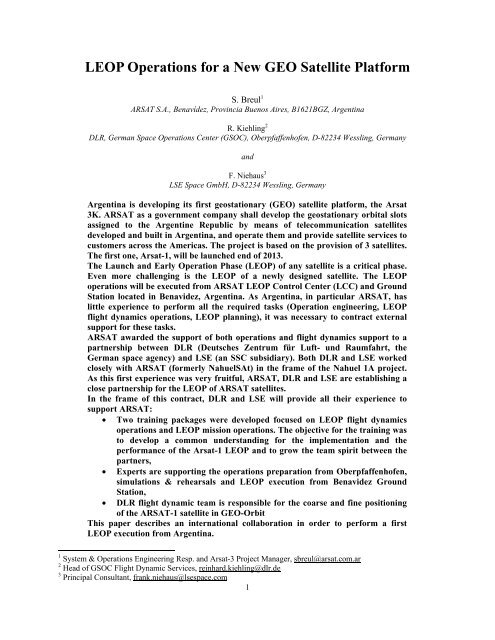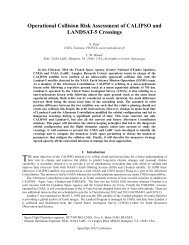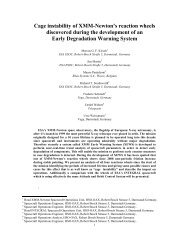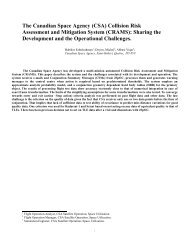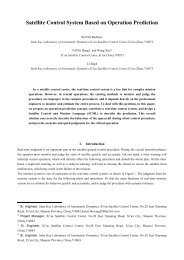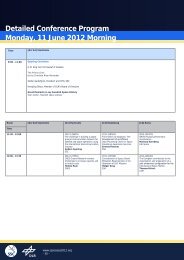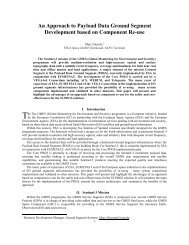LEOP Operations for a New GEO Satellite Platform - SpaceOps 2012
LEOP Operations for a New GEO Satellite Platform - SpaceOps 2012
LEOP Operations for a New GEO Satellite Platform - SpaceOps 2012
Create successful ePaper yourself
Turn your PDF publications into a flip-book with our unique Google optimized e-Paper software.
<strong>LEOP</strong> <strong>Operations</strong> <strong>for</strong> a <strong>New</strong> <strong>GEO</strong> <strong>Satellite</strong> Plat<strong>for</strong>m<br />
S. Breul 1<br />
ARSAT S.A., Benavídez, Provincia Buenos Aires, B1621BGZ, Argentina<br />
R. Kiehling 2<br />
DLR, German Space <strong>Operations</strong> Center (GSOC), Oberpfaffenhofen, D-82234 Wessling, Germany<br />
and<br />
F. Niehaus 3<br />
LSE Space GmbH, D-82234 Wessling, Germany<br />
Argentina is developing its first geostationary (<strong>GEO</strong>) satellite plat<strong>for</strong>m, the Arsat<br />
3K. ARSAT as a government company shall develop the geostationary orbital slots<br />
assigned to the Argentine Republic by means of telecommunication satellites<br />
developed and built in Argentina, and operate them and provide satellite services to<br />
customers across the Americas. The project is based on the provision of 3 satellites.<br />
The first one, Arsat-1, will be launched end of 2013.<br />
The Launch and Early Operation Phase (<strong>LEOP</strong>) of any satellite is a critical phase.<br />
Even more challenging is the <strong>LEOP</strong> of a newly designed satellite. The <strong>LEOP</strong><br />
operations will be executed from ARSAT <strong>LEOP</strong> Control Center (LCC) and Ground<br />
Station located in Benavidez, Argentina. As Argentina, in particular ARSAT, has<br />
little experience to per<strong>for</strong>m all the required tasks (Operation engineering, <strong>LEOP</strong><br />
flight dynamics operations, <strong>LEOP</strong> planning), it was necessary to contract external<br />
support <strong>for</strong> these tasks.<br />
ARSAT awarded the support of both operations and flight dynamics support to a<br />
partnership between DLR (Deutsches Zentrum für Luft- und Raumfahrt, the<br />
German space agency) and LSE (an SSC subsidiary). Both DLR and LSE worked<br />
closely with ARSAT (<strong>for</strong>merly NahuelSAt) in the frame of the Nahuel 1A project.<br />
As this first experience was very fruitful, ARSAT, DLR and LSE are establishing a<br />
close partnership <strong>for</strong> the <strong>LEOP</strong> of ARSAT satellites.<br />
In the frame of this contract, DLR and LSE will provide all their experience to<br />
support ARSAT:<br />
Two training packages were developed focused on <strong>LEOP</strong> flight dynamics<br />
operations and <strong>LEOP</strong> mission operations. The objective <strong>for</strong> the training was<br />
to develop a common understanding <strong>for</strong> the implementation and the<br />
per<strong>for</strong>mance of the Arsat-1 <strong>LEOP</strong> and to grow the team spirit between the<br />
partners,<br />
Experts are supporting the operations preparation from Oberpfaffenhofen,<br />
simulations & rehearsals and <strong>LEOP</strong> execution from Benavidez Ground<br />
Station,<br />
<br />
DLR flight dynamic team is responsible <strong>for</strong> the coarse and fine positioning<br />
of the ARSAT-1 satellite in <strong>GEO</strong>-Orbit<br />
This paper describes an international collaboration in order to per<strong>for</strong>m a first<br />
<strong>LEOP</strong> execution from Argentina.<br />
1 System & <strong>Operations</strong> Engineering Resp. and Arsat-3 Project Manager, sbreul@arsat.com.ar<br />
2 Head of GSOC Flight Dynamic Services, reinhard.kiehling@dlr.de<br />
3 Principal Consultant, frank.niehaus@lsespace.com<br />
1
I. Introduction<br />
ARSAT, is a company established by the Argentine Government under a law passed in 2006. The Law of<br />
creation establishes that ARSAT shall develop the geostationary orbital slots assigned to the Argentine Republic by<br />
means of telecommunications satellites developed and built in Argentina, and operate them and provide satellite<br />
services to customers across the Americas.<br />
The law reflects<br />
a. The Government’s strong commitment to strengthen domestic satellite development industry and<br />
b. The high strategic value assigned to the use of orbital slots to attain a socioeconomic impact<br />
Currently, the single shareholder is the Argentine State. The company <strong>for</strong>esees the participation of private capital in<br />
the future.<br />
ARSAT currently holds exclusive rights to operate satellite networks at 72°W and 81°W longitude orbital slots<br />
covering the Americas<br />
The project called SSGAT, Sistema Satelital Geo Argentino de Telecomunicaciones (in English, Argentinean<br />
Telecommunications Geo <strong>Satellite</strong> System) is based on the provision of 3 satellites based on the same plat<strong>for</strong>m.<br />
a. Arsat-1 will be launched end of 2013,<br />
b. Arsat-2 will be launched end of 2014,<br />
c. Arsat-3 will be launched end of 2015.<br />
The objective is to have a recurrent plat<strong>for</strong>m with different type of payload including different Radio Frequency<br />
(RF) Band.<br />
ARSAT is at the same time the sponsor of the project (and even procuring most of the equipments) and the client.<br />
INVAP is the prime contractor <strong>for</strong> the satellite.<br />
The main plat<strong>for</strong>m characteristics are:<br />
a. Design lifetime: 15 years,<br />
b. Total launch mass: circa 3 tons ,<br />
c. Power consumption: 4.2 kW with a Payload consumption of 3.4 kW,<br />
d. Attitude and Orbit Control System (AOCS) Sensors: ST - Star tracker, FSS - Fine Sun Sensor, IRES -<br />
InfraRed Earth Sensor, MIMU - Miniature Inertial Measurement Unit and Actuators: Reaction Wheels,<br />
10N thrusters, 400N LAE - Liquid Apogee Engine.<br />
II. General overview of a critical phase<br />
The <strong>LEOP</strong> is one of the most critical phases of a mission. These operations take place from the separation of<br />
satellite from the launcher. During this phase the first contact between satellite and ground is established, the<br />
satellite is configured and driven on its final orbital position.<br />
Criticality of this phase is mainly due to the initial switch on of the satellite's elements after the launch phase<br />
stress. Swift reactions of the operational team are mandatory <strong>for</strong> nominal operation and furthermore in case of<br />
contingencies, to ensure a very efficient execution of the post-separation operations to account <strong>for</strong> the limited power<br />
autonomy. The success of operations is depending on both a well-trained and seasoned operations and flight<br />
dynamics team and a reliable set of ancillary means (LCC – <strong>LEOP</strong> Control Center, communications network and<br />
<strong>LEOP</strong> network).<br />
So, this <strong>LEOP</strong> is a set of complex operations involving flight proven, heavy and particular means as well as<br />
experienced staff. In addition to operational and ground segment skills, these operations need a permanent and<br />
proactive dialog with the satellite experts.<br />
As ARSAT and its prime contractor, INVAP, have little experience, there<strong>for</strong>e it was necessary to contract<br />
external support <strong>for</strong> these tasks and to establish an international collaboration.<br />
III. Arsat-1 <strong>LEOP</strong> concept<br />
In order to minimize the technical and schedule risks, ARSAT has decided to use a classical <strong>LEOP</strong> configuration<br />
and organization.<br />
A. <strong>LEOP</strong> Configuration<br />
The control of the satellites during <strong>LEOP</strong> will involve the ARSAT LCC and the associated Ground Station in<br />
Benavidez (close to Buenos Aires city), a world-wide Ground Station Network (GSN), communications links,<br />
2
computer and software facilities. The GSN (provision awarded to Telespazio) will comprise a number of TT&C<br />
stations suitably located around the Earth. The GSN will be compatible with the launch vehicle orbits and provide<br />
dual site coverage during critical activities such as initial acquisition, apogee motor firing and reorientation<br />
manoeuvres. Anyway, any station shall recover main services (TM/TC) as soon as possible in case of an antenna<br />
failure when no dual site was <strong>for</strong>eseen.<br />
The <strong>LEOP</strong> Control Center will contain all the necessary hardware and software to support the <strong>LEOP</strong> including<br />
the following functionalities of the Flight Dynamics adapted to Arsat-1 On Orbit Control (OOC):<br />
a. Orbit Determination and Maneuver Calibration<br />
b. Maneuver Planning<br />
c. Generation of Orbit-Related In<strong>for</strong>mation<br />
d. Co-location Monitoring<br />
The <strong>LEOP</strong> Control Center will include in particular, capabilities to process and display telemetry, generate and<br />
transmit commands, validate commands be<strong>for</strong>e transmission, verify correct execution of commands by software,<br />
retrieve telemetry and command data <strong>for</strong> anomaly analyses, per<strong>for</strong>m tone ranging and angular measurements,<br />
implement the Apogee Engine Firing (AEF) manoeuvres, monitor and control the satellite orbit and attitude and<br />
communicate with the GSN stations and the launch site.<br />
The <strong>LEOP</strong> Control Center will include an area <strong>for</strong> the satellite specialists, containing monitoring consoles, a<br />
proper voice loop system, printer devices, a time display and the necessary furniture. This configuration will be<br />
made available during validation, qualification and operations.<br />
B. <strong>LEOP</strong> Organization<br />
Several teams can be identified in the <strong>LEOP</strong> service, <strong>for</strong> decision authorities, mission responsibilities, satellite<br />
experts, satellite operations, flight dynamics operations, and ground segment operations as defined here below.<br />
In Contingencies<br />
In Contingencies<br />
Figure 1. Arsat-1 <strong>LEOP</strong> Organization<br />
The Decision Authorities (DA) are composed of the project manager both from ARSAT and the Prime<br />
Manufacturer.<br />
3
The Mission <strong>Operations</strong> Director (MOD) <strong>for</strong>med by ARSAT, Prime Manufacturer and a subcontractor has the<br />
responsibility <strong>for</strong> the Mission Support Service during <strong>LEOP</strong> preparation and operations execution. Nonetheless,<br />
MOD is assigned to control aspects during <strong>LEOP</strong> operations (preparation, rehearsal and execution). In emergency<br />
situations, MOD receives instructions from the DA.<br />
Their specific responsibilities include:<br />
a. Controlling the <strong>LEOP</strong> operations progress in order to safeguards satellite health and enables mission<br />
objectives<br />
b. Handling the operations meetings and anomaly meetings<br />
c. Coordinating the GO/NO GO criteria <strong>for</strong> critical operation<br />
d. Giving the authorization to begin the Flight <strong>Operations</strong> Procedures<br />
The <strong>Satellite</strong> Team Leader (STL) heads a team of <strong>Satellite</strong> Experts coming from the Prime Manufacturer. He has<br />
the responsibility <strong>for</strong> providing a coordinated system view of the satellite health and per<strong>for</strong>mance.<br />
Their specific responsibilities include:<br />
a. Following the progress of satellite commanding in order to send the correct commands and to per<strong>for</strong>m<br />
functional verification<br />
b. Reporting anomalies behavior<br />
c. Reporting GO/NO GO status<br />
d. In case of anomaly, recommend a contingency procedure under the MOD responsibility in association with<br />
the SOM<br />
The <strong>Satellite</strong> Experts monitor, in real-time, the current status of the various subsystems of the satellite and<br />
confirms to the STL, as appropriate, whether the satellite behavior is nominal or not.<br />
The <strong>Satellite</strong> <strong>Operations</strong> Manager (SOM) is the leader of the <strong>Satellite</strong> Control Console, including the <strong>Satellite</strong><br />
Controllers. SOM has a direct authority regarding the satellite telemetry monitoring and telecommand sending.<br />
Their specific responsibilities include:<br />
a. Execution of approved FOPs by assisting <strong>Satellite</strong> Controllers with command verification and related data<br />
checking<br />
b. Verification of satellite health and status monitoring and anomaly reporting<br />
c. Coordination with STL to ensure that they are ready to support command and the satellite health and status<br />
are as expected.<br />
d. Keeping the <strong>Satellite</strong> Controllers in<strong>for</strong>med of progress against the procedure<br />
e. Maintenance of the <strong>Satellite</strong> operations logbook<br />
The <strong>Satellite</strong> Controllers execute the FOPs following the SOM requirements and monitor the satellite telemetry.<br />
The Flight Dynamics Team Leader is responsible <strong>for</strong> the generation of all required products and is the point of<br />
contact between the FD Team and the SOM and MOD.<br />
The FDTL specific responsibilities include:<br />
a. To develop the overall technical and operational concept to per<strong>for</strong>m the assigned Flight Dynamics <strong>LEOP</strong> task<br />
b. To coordinate all flight dynamic tasks<br />
c. To report during mission execution the current FD activities and results to MOD<br />
The FDT executes all flight dynamics tasks.<br />
The Ground <strong>Operations</strong> Manager is responsible <strong>for</strong> operating the ground system including the Ground System<br />
Network<br />
The GOM specific responsibilities include:<br />
a. To maintain telemetry and telecommand links with the satellite<br />
b. Management of software maintenance including operating system<br />
c. Monitoring and operating specific hardware<br />
d. Coordination a contingency plan in case of ground segment problems<br />
C. <strong>LEOP</strong> Risks and Mitigations<br />
4
The <strong>LEOP</strong> is the most critical of all phases of a mission and usually lasts anywhere from a few days to some<br />
weeks. Several causes may occur during this phase as:<br />
Technical failure on satellite (e.g. apogee motor, solar panels deployment),<br />
Technical failure in ground station (e.g. SCC software error, major incident e.g. power cut, failure),<br />
Not representative operations software: Dynamic <strong>Satellite</strong> Simulator (DSS) and Flight Dynamics<br />
Software (FDS)<br />
Unanticipated technical issues,<br />
Inexperience of the <strong>LEOP</strong> staff,<br />
Erroneous command instruction,<br />
No flight reference of the operational material such as databases, procedures, etc.<br />
All these risks shall be minimized as possible <strong>for</strong> each mission. Knowing that Arsat-1 is a new <strong>GEO</strong> plat<strong>for</strong>m<br />
and the Ground segment is an updated of the one used <strong>for</strong> Nahuel 1A, all these risks may be considered.<br />
The support from DLR and LSE on <strong>LEOP</strong> flight dynamics operations and <strong>LEOP</strong> mission operations preparations<br />
and executions allow to reduce some of these risks.<br />
IV. Arsat-1 <strong>LEOP</strong> collaboration<br />
A. Historic Collaboration<br />
In 1993 NahuelSAt was founded by the European companies Aerospatiale (France), DASA (Germany) and<br />
Alenia Spazio (Italy). The telecommunication satellite Nahuel 1A was launched on January 30 th , 1997 with Ariane<br />
44L and positioned at 71.8°W. The <strong>LEOP</strong> was executed by CNES. The on station control (OOC) operations as well<br />
as the payload management and signal uplink were to be carried out from the newly built control center in<br />
Benavidez.<br />
In this consortium Aerospatiale was responsible <strong>for</strong> the delivery of the telecommunications satellite based on the<br />
Spacebus2000 plat<strong>for</strong>m. Additionally they delivered training to the Argentinean <strong>Satellite</strong> <strong>Operations</strong> Engineers.<br />
Aerospatiale provided a team of own flight operations engineers <strong>for</strong> the procedure development, the training<br />
activities and the initial stage of On Station <strong>Operations</strong>.<br />
During the final operations preparation phase 1996-1997 Aerospatiale awarded a contract to LSE Space GmbH<br />
in order to support the operations preparation and training activities and the first months of the OOC operations. The<br />
main activities consisted in the site acceptance of the <strong>Satellite</strong> Control Center (SCC) software and the customization<br />
of the flight operations procedures using this SCC. Furthermore, experience gathered in a large number of<br />
geostationary satellite projects was shared with the Argentinean colleagues who were supposed to operate the<br />
Nahuel 1A satellite <strong>for</strong> a lifetime of 12-15 years. This knowledge transfer occurred in a set of training courses both<br />
with class room as well as with hands-on lessons using the ground segment components driven by the software<br />
simulator from the satellite manufacturer.<br />
The SCC software has been delivered by DLR/GSOC under a subcontract from Alenia Spazio. DLR<br />
subcontracted LSE Space so as to support them in this delivery to the satellite control center in Benavidez and to<br />
carry out site acceptance tests. In addition, DLR/GSOC provided the GeoControl software package <strong>for</strong> station<br />
keeping operations and has trained the personnel <strong>for</strong> its use in on-station operations. In 2008 DLR/GSOC has<br />
provided ARSAT with an upgrade of the software package.<br />
Eventually, LSE provided their experience and their expertise through different partners and through different<br />
subcontracts, always ensuring a customer oriented service attitude without any conflicts of interest by applying a<br />
pure technical and pragmatic approach to the tasks.<br />
In summary it can be said, that be<strong>for</strong>e the mid 1990s there was no activity in the scope of operating and<br />
managing telecommunication satellites on orbit at all in Argentina. A complete ground station and a complete<br />
Control Center together with the teams of engineers, operators and managers had to be built from scratch. DLR and<br />
LSE could contribute to the final success with their background and their vast experience. Now, 15 years later it is a<br />
new constellation with ARSAT as the follow-up satellite operator to NahuelSAt and with INVAP as a domestic<br />
satellite manufacturer. This also means a new challenge to which both DLR and LSE will provide their long term<br />
experience. Knowing the environment quite well and also being familiar with a number of the ARSAT staff from the<br />
previous NahuelSAt days, well established communication paths exist and problems can be tackled without a<br />
lengthy phase-in and familiarization period.<br />
5
In the Nahuel 1A project, an approach had been taken by NahuelSAt to have the domestic engineers and<br />
operators trained by experienced <strong>for</strong>eign staff when finally they took over the overall operations activities. In this<br />
way, dependencies from the industries outside of Argentina were rather limited. In ARSAT this path is now<br />
consequently continued. Support is being purchased by ARSAT <strong>for</strong> various areas of consultancy requirements. The<br />
satellite is not procured turn key from one of the well known international providers, but assembled and integrated in<br />
Argentina using national experience. This is also true <strong>for</strong> the satellite control center elements such as the SCC, as<br />
well as <strong>for</strong> the operational teams.<br />
B. Training Packages<br />
In an early stage of the project a comprehensive training was provided by DLR/GSOC and LSE as part of the<br />
contract.<br />
ARSAT has experienced engineers <strong>for</strong> routine and contingency operations of geostationary satellites. There<strong>for</strong>e<br />
the characteristics and special features of geo-stationary <strong>LEOP</strong> operations and their differences to routine operations<br />
were scope of the training.<br />
The objective of the per<strong>for</strong>med training was the achievement of a common understanding <strong>for</strong> implementation of<br />
the Arsat-1 <strong>LEOP</strong> by detailed lectures and exemplary exercises. The training was also used to identify items to be<br />
clarified and possible problems.<br />
The following training modules were per<strong>for</strong>med:<br />
1. Flight Dynamics Training Module A: Mission Analysis and Mission Preparation (2 weeks)<br />
2. Flight Dynamics Training Module B: Flight Dynamics <strong>LEOP</strong> <strong>Operations</strong> (2 weeks)<br />
3. Ground Data Systems (2 days)<br />
4. Mission <strong>Operations</strong> (3 days)<br />
In the following, details of the modules are given.<br />
1. Flight Dynamics Training Module A: Mission Analysis and Mission Preparation<br />
In a first introductory training session the fundamentals and definitions of Astrodynamics relevant <strong>for</strong> geomissions<br />
were addressed. The general scenario with main events of a geo-stationary <strong>LEOP</strong> was discussed.<br />
The second part covered the planning of the Ground Station Network (GSN) <strong>for</strong> a geo-stationary positioning<br />
taking into account mission specific requirements as dual site station visibility during critical operations (e.g. first<br />
acquisition, apogee boost maneuvers, etc.). Relevant <strong>for</strong> this planning are the <strong>for</strong>eseen launcher (Ariane V in this<br />
case), the specified transfer orbit and the location of spacecraft separation from the launcher. Exercises were<br />
per<strong>for</strong>med taking into account the possible GSN stations <strong>for</strong> the Arsat-1 <strong>LEOP</strong>.<br />
In the following part the planning of positioning strategies was per<strong>for</strong>med including extensive exercises based on<br />
the possible Arsat-1 <strong>LEOP</strong> GSN and targeting to the planned Arsat-1 IOT location on the <strong>GEO</strong>. In a first step 3-<br />
impulse strategies <strong>for</strong> the apogee boost maneuvers were designed including backup solutions <strong>for</strong> each maneuver.<br />
Criteria <strong>for</strong> maneuver sizing with respect tothe following Fine Station Acquisition phase were discussed. Robustness<br />
of the strategies in view of transfer orbit dispersions and maneuver execution errors were investigated. 4-impulse<br />
strategies were developed and their advantages and disadvantages with respect to a 3-impulse strategy were<br />
analyzed.<br />
The fourth part covered the computation of a launch window <strong>for</strong> a geo-stationary mission. Different classes of<br />
launch window constraints were addressed as Earth or Moon shadows, various types of Sun- and Moon-related<br />
angles and sensor interferences. An exemplary launch window computation considering typical constraints was<br />
exercised. Possible launch window constraints <strong>for</strong> Arsat-1 were discussed.<br />
The last part in the first Flight Dynamics Training module covered the Sequence of Events (SOE) of a geostationary<br />
<strong>LEOP</strong> and the products to be provided by Flight Dynamics <strong>for</strong> its generation based on <strong>LEOP</strong>s per<strong>for</strong>med<br />
by DLR/GSOC in the past. Differences to the Arsat-1 <strong>LEOP</strong> were discussed.<br />
2. Flight Dynamics Training Module B: Flight Dynamics <strong>LEOP</strong> <strong>Operations</strong><br />
The first part of the second Flight Dynamics Training module addressed the Flight Dynamics tasks during a geostationary<br />
<strong>LEOP</strong>. From these tasks the architecture of the <strong>LEOP</strong> Flight Dynamics System (FDS) is derived.<br />
Operational interfaces to Flight <strong>Operations</strong> System (FOS) and Ground Station Network (GSN) were identified,<br />
especially possible adaptations to the Arsat-1 <strong>LEOP</strong>. In addition, a WEB-based intranet in the satellite control center<br />
used <strong>for</strong> the distribution of Flight-Dynamics-related in<strong>for</strong>mation to the operations team was presented.<br />
The next part covered the preparation of Flight Dynamics <strong>LEOP</strong> <strong>Operations</strong> including development of Flight<br />
Dynamics Ground Procedures and delivery of nominal <strong>LEOP</strong> products to FOS and GSN.<br />
6
The third section comprised launch and first Flight Dynamics operations including various practical exercises.<br />
First task was the initial orbit determination after reception of tracking data, which were simulated and provided in<br />
several portions. The implementation of an Apogee Boost Maneuver rehearsal is supported by Flight Dynamics by<br />
provision of corresponding attitude transition data. Necessary adaptations of the present DLR/GSOC-FDS <strong>for</strong> the<br />
Arsat-1 <strong>LEOP</strong> with respect to this process were discussed. The positioning strategy is updated based on the initial<br />
orbit determination. Flight Dynamics products are delivered to FOS and GSN. Different possible Transfer Orbit<br />
Contingency cases as ‘No Signal from Spacecraft’, ‘Transfer Orbit Injection with Low/High Perigee’, ‘Propulsion<br />
System Leakage’ were addressed. How to react on these contingencies was trained in various exercises.<br />
The fourth part dealt with planning, execution and reconstruction of an Apogee Boost Maneuver. The process<br />
started with a pre-maneuver orbit determination. Second step was the optimization of maneuver parameters (ignition<br />
time, burn duration and thrust direction) with respect to minimize the overall fuel consumption <strong>for</strong> the positioning of<br />
the satellite at its target longitude. An important input to the maneuver optimization is the prediction of thrust level<br />
and mass flow rate <strong>for</strong> the planned maneuver, which needs support of the apogee engine experts. Flight Dynamics<br />
provides Maneuver Planning data to FOS and delivers updates of products to support FOS and GSN operations<br />
including pointing data <strong>for</strong> the tracking antennas. Flight dynamics is also prepared <strong>for</strong> possible ABM contingencies<br />
such as ‘Ignition Time Delay’, ‘UPS Leakage after end of burn’ and ‘Positioning with 10 N Thruster (in case of<br />
ABM-motor failure)’. The per<strong>for</strong>mance of the maneuver is reconstructed by a post-maneuver orbit determination.<br />
This process in close collaboration with the engine experts provides a calibration which is used <strong>for</strong> the<br />
implementation of the following maneuver. All described processes were discussed in detail and trained in extensive<br />
exercises.<br />
The scope of the last part was the Fine Station Acquisition phase which brings the satellite from a drift orbit<br />
achieved by the main engine firings to the final location on the geo-stationary orbit using the small thrusters of the<br />
satellite. The fine station acquisition planning was exercised under the aspect that close conjunctions with other<br />
satellite control boxes are to be avoided. The current situation of satellites around the planned Arsat-1 IOT position<br />
was assumed and part of the training. To be prepared <strong>for</strong> non-nominal execution of the fine station acquisition,<br />
coordination with other satellite control centers by exchange of orbit data was discussed. Simulated orbit data of the<br />
other satellites close to the Arsat-1 IOT position were used to train co-location and conjunction monitoring. After<br />
selection of the most favorable fine station acquisition strategy the implementation and calibration of the maneuvers<br />
were exercised.<br />
3. Ground Data Systems<br />
In the Ground Data System module, the training started off with an introduction on the various components of a<br />
Ground Station Network as required during a <strong>LEOP</strong>, in particular the interfaces to other entities such as Flight<br />
Dynamics and Flight <strong>Operations</strong> were introduced.<br />
Design drivers of a Ground Station Network such as the availability, redundancy aspects, link margins and<br />
security issues have been discussed prior to the definition of the Arsat-1 specific GSN requirements.<br />
The training continued with the definition of the products <strong>for</strong> exchange within the GSN, in particular the<br />
required protocols and the specific exchange interfaces. The mapping of the Space-to-Ground Interface Control<br />
Document (S/G ICD) to the different configurations of the ground stations, namely the RF interface considerations,<br />
<strong>for</strong>med an important module within the training block.<br />
Cost structure and cost drivers have been discussed and a number of exercises completed the sessions be<strong>for</strong>e the<br />
design part of the GDS training was terminated.<br />
In the GDS operations part of the training, the different phases and the associated activities during the GSN<br />
preparation and the mission execution were trained, exercised and discussed.<br />
The development of test plans and the execution of the relevant tests including the proper reporting of system<br />
and staff per<strong>for</strong>mances have been exercised, too.<br />
A core element <strong>for</strong> the improvement of coordination between different GSN partners in GDS operations, the<br />
GDS-relevant Sequence of Events and its generation and use were shown, be<strong>for</strong>e aspects of Operational Readiness<br />
have been discussed.<br />
The GDS training was concluded with a detailed demonstration of the organization of the Network <strong>Operations</strong><br />
Center (NOC) console, the required documentation and the typical voice traffic during pre-launch and <strong>LEOP</strong><br />
activities, particularly on first acquisition issues.<br />
Exercises on TM&TC service per<strong>for</strong>mance metrics, link budget and detailed ranging per<strong>for</strong>mance analysis, as<br />
well as on troubleshooting methods completed this part of the training.<br />
4. Mission <strong>Operations</strong><br />
7
In this training module, the main elements in mission operations such as the FOS-relevant Sequence of Events,<br />
the Flight <strong>Operations</strong> Plan and a selection of auxiliary operations tools have been introduced to the teams of trainees.<br />
One session on the reporting of anomalies and recommendations and how to handle non-nominal situations and one<br />
session to refresh the participants’ voice operations skills were held in this context.<br />
Mainly the aspects of satellite operations during the positioning phase have been addressed. This culminated in<br />
the execution of a small <strong>LEOP</strong> simulation which was scheduled more or less ad-hoc. Due to the fact that the trainees<br />
were extremely busy every day of the training courses, they had little preparation time and very little familiarization<br />
with the specific operational systems and elements used at DLR/GSOC, e.g. the control room layout, the MCS, the<br />
procedure <strong>for</strong>mat and many others.<br />
The trainees were taking over dedicated roles/positions within the operations team, such as <strong>Operations</strong> Director,<br />
<strong>Satellite</strong> Team Lead, Subsystem Engineers, <strong>Satellite</strong> Operator and GDS NOC etc. All positions were double manned<br />
in order to reduce the work load. Additionally the trainees were supported by experienced mission operations staff<br />
from DLR/GSOC including the Flight Dynamics position.<br />
During this simulation, the operations and associated procedures following the satellite’s separation from the<br />
launcher up to the partial deployment of the solar arrays were per<strong>for</strong>med, such as: Health Check of the different<br />
satellite subsystems by the responsible and dedicated subsystem engineers, Propulsion subsystem Venting and<br />
Pressurization, 1 st Sun Acquisition, Solar Array Partial Deployment.<br />
This exercise was well appreciated as all the aspects of the preceding trainings were addressed and required, in<br />
order to successfully manage the tasks during the simulated <strong>LEOP</strong>. It became very evident how much expertise,<br />
exercise and proficiency will still be necessary in order to successfully carry out the Arsat-1 <strong>LEOP</strong>.<br />
C. <strong>Operations</strong> Support<br />
The role of LSE in the framework of the support contract between DLR and ARSAT consists in the provision of<br />
consultancy services during the <strong>Operations</strong> Preparation phase as a sub-contractor of DLR. During the simulation and<br />
rehearsal phase as well as during the <strong>LEOP</strong> phase LSE will provide the staffing of the Deputy <strong>Operations</strong> Director<br />
(DOD) position. With the end of the <strong>LEOP</strong> a final <strong>LEOP</strong> Post Mission Report will be provided, describing in detail<br />
the results of the positioning phase and the per<strong>for</strong>mance of the satellite, the ground station network, the ground<br />
operations segment and of the associated teams.<br />
Over the past 23 years LSE has accumulated experience in the operations of geostationary telecommunication<br />
satellites based upon various generations of European built satellite plat<strong>for</strong>ms (Spacebus and Eurostar). LSE staff<br />
involved in the Arsat-1 mission have participated in approximately 30 missions in various functions to customers<br />
such as Eutelsat, SES, DLR/GSOC, Arabsat, Yahsat, German Telecom, German Army and of course, NahuelSAt<br />
either through a direct contract or through a subcontract by another party.<br />
LSE took various roles in the technical area but also in the mission management area. They provided a highly<br />
needed cost efficient and quality driven service in very close relationship to their customers.<br />
In the scope of the Arsat-1 mission, the focus of the support from LSE will be the support and the backing of the<br />
Mission <strong>Operations</strong> Director. On the management side, LSE will play an active role in the preparation and execution<br />
of the classical Milestone Reviews. Furthermore, special emphasis will be given during the operations preparation<br />
phase on activities such as the definition, the validation and the realization of operational processes and procedures.<br />
These will be enacted and overlooked in particular during the simulation and rehearsal campaigns. Contributions<br />
will be made in the generation of the Flight <strong>Operations</strong> Sequence of Events and in the staff planning <strong>for</strong> the mission<br />
itself.<br />
Having the role of the Deputy <strong>Operations</strong> Director, LSE will oversee during the simulation and rehearsal phase<br />
the interactions of the various individuals and teams, the quality of the used operational products and tools and<br />
finally deliver a Qualification and Per<strong>for</strong>mance Report.<br />
Finally during the <strong>LEOP</strong> mission of Arsat-1 the DOD will be on site in the Benavidez SCC on a 24/7 basis in<br />
order to interchange with the MOD in order to monitor the flow of flight and ground operations, to consult and<br />
follow up anomaly operations where needed and to report to the MOD.<br />
With the satellite finally being positioned at its desired longitude, a special Post mission Analysis and<br />
Per<strong>for</strong>mance Report will be compiled and submitted to ARSAT as “Lessons Learnt”. It will <strong>for</strong>m an important input<br />
<strong>for</strong> the upcoming Arsat <strong>LEOP</strong>s.<br />
D. Flight Dynamics<br />
1. DLR/GSOC Experience in Field of Geo-Stationary Missions<br />
DLR/GSOC has successfully positioned 20 geo-stationary communication satellites on station since 1974<br />
beginning with involvement in the German-French SYMPHONIE program. Between 1987 and 2002 GSOC was<br />
8
esponsible <strong>for</strong> the <strong>LEOP</strong>s of various geostationary satellites <strong>for</strong> EUTELSAT (European Telecommunications<br />
<strong>Satellite</strong> Organization) and <strong>for</strong> German Telecom. For some of the national missions GSOC also has per<strong>for</strong>med<br />
routine operations including station keeping. At last DLR/GSOC has positioned COMSATBw-1 & 2 <strong>for</strong> the German<br />
Military Services and is currently the control center <strong>for</strong> routine operations and station keeping of these two geostationary<br />
satellites. GSOC also supported various external agencies in the field of geo-stationary missions, and<br />
provided NahuelSAt with its Flight Dynamics software.<br />
2. Operational Concept of the Flight Dynamics Service <strong>for</strong> Arsat-1<br />
Flight Dynamics <strong>LEOP</strong> <strong>Operations</strong> <strong>for</strong> the Arsat-1 satellite will be executed by a DLR team at the ARSAT<br />
<strong>Satellite</strong> Control Center (SCC) in Benavidez. The presence of Flight Dynamics experts per<strong>for</strong>ming their operations<br />
on site within the <strong>LEOP</strong> SCC ensures a close interaction with mission operations and satellite manufacturer which is<br />
essential especially in the following cases and tasks:<br />
a. Strategy fine-tuning or re-planning;<br />
b. Implementation of maneuver-related contingencies (e.g. ignition time delay etc.);<br />
c. Fine station acquisition planning satisfying all operational and technical constraints;<br />
d. Implementation of thruster per<strong>for</strong>mance <strong>for</strong>ecasts <strong>for</strong> maneuver preparation;<br />
e. Calibration of executed maneuvers and the consequences <strong>for</strong> upcoming maneuvers;<br />
f. Occurrence of special events (e.g. interferences etc.);<br />
g. Flight dynamics analyses in case of non-nominal situations.<br />
All these situations would be more difficult to handle in case of a remote Flight Dynamics Support located at<br />
DLR/GSOC premises.<br />
3. <strong>LEOP</strong> Preparation<br />
a) The <strong>LEOP</strong> Flight Dynamics System<br />
The GSOC Flight Dynamics System (FDS) <strong>for</strong> geo-stationary missions is a widely plat<strong>for</strong>m-independent generic<br />
system which is flight proven in numerous missions. Usually adaptations of the system are needed due to specific<br />
plat<strong>for</strong>m characteristics such as launch window constraints, gyro calibration, generation of parameters <strong>for</strong> attitude<br />
transition into maneuver attitude, maneuver attitude profiles, maneuver execution parameters to be commanded to<br />
the s/c, sensor interference predictions, wheel unloading, etc.<br />
DLR/GSOC will per<strong>for</strong>m a requirement analysis <strong>for</strong> the FDS S/W and H/W and will design the architecture of<br />
the FDS including all data interfaces to FOS and GSN to be implemented to support the Arsat-1 <strong>LEOP</strong>. Data<br />
provided by FDS are parameters <strong>for</strong> maneuver execution commands, event files <strong>for</strong> FOS and GSN operations<br />
planning (SOE), in<strong>for</strong>mation and WEB Files to ARSAT intranet to support the Flight <strong>Operations</strong> Team with orbitrelated<br />
in<strong>for</strong>mation, current orbit data <strong>for</strong> antenna pointing purposes. Input to FDS are tracking data files containing<br />
range and angle data used <strong>for</strong> orbit determination.<br />
The FDS will run in DLR/GSOC furnished workstations, which will exchange data (tracking and ranging files,<br />
FDS products and intranet updates) according to an ICD. The work will be easier as parts of the <strong>LEOP</strong> FDS are<br />
shared with the current ARSAT OOC FDS.<br />
b) Mission Analysis<br />
One of the main tasks of Flight Dynamics Support during the preparation of the Arsat-1 <strong>LEOP</strong> is the per<strong>for</strong>mance of<br />
a mission analysis comprising<br />
a. Assessment of Ground Station Network (GSN);<br />
b. Analysis of first acquisition conditions at separation from the launcher;<br />
c. Design of positioning strategies including backup maneuver tree;<br />
d. Estimation of ∆V-budget <strong>for</strong> the positioning;<br />
e. Launch window computation;<br />
f. Computation of relevant events (ground station visibility, shadows, sensor interference etc.);<br />
g. Fine Station Acquisition Analysis.<br />
c) Operational Preparation<br />
The planning of Flight Dynamics <strong>Operations</strong> during the <strong>LEOP</strong> comprises the generation of nominal and<br />
contingency Flight Dynamics Ground Procedures. These procedures specify all flight dynamics activities to be<br />
carried out during the service in order to bring the satellite to its geostationary In-Orbit Test (IOT) position covering<br />
also non-nominal situations.<br />
9
The Flight Dynamics Sequence of Events and Shift and Manpower plan will be generated in close coordination<br />
with Flight- and Ground Station Network operations.<br />
For support of the generation of FOS and GSN sequence of events Flight Dynamics will provide orbit-related<br />
in<strong>for</strong>mation comprising ground station visibility, shadow events, specific angles and sensor interference, maneuvers,<br />
and others, as applicable.<br />
Flight Dynamics will implement with assistance of ARSAT data exchange processes with other satellite control<br />
centers which operate satellites close to the Arsat-1 IOT target position to be prepared <strong>for</strong> orbit coordination during<br />
Fine Station Acquisition in order to minimize collision risks in case of non-nominal situations.<br />
The GSOC Flight Dynamics Team is experienced from numerous geo-stationary <strong>LEOP</strong>s per<strong>for</strong>med in the past.<br />
Peculiarities of the <strong>LEOP</strong> of the new Arsat-1 plat<strong>for</strong>m will be addressed first in classroom sessions and simulations<br />
at DLR/GSOC premises well be<strong>for</strong>e the <strong>LEOP</strong>. The GSOC Flight Dynamics Team will then participate in Mission<br />
Rehearsals per<strong>for</strong>med at the <strong>LEOP</strong> SCC in Benavidez in order to get familiarized with the <strong>Operations</strong> at the SCC, to<br />
validate finally the Flight Dynamics Procedures and to harmonize the interactions between all involved parties.<br />
4. Flight Dynamics <strong>LEOP</strong> <strong>Operations</strong><br />
The GSOC Flight Dynamics Team will conduct the following main tasks <strong>for</strong> support of the Arsat-1 <strong>LEOP</strong>:<br />
a. Orbit determination and prediction;<br />
b. Generation and delivery of flight dynamics related in<strong>for</strong>mation required by FOS and GSN;<br />
c. Generation and delivery of current orbit or pointing data <strong>for</strong> ground stations;<br />
d. Re-planning of positioning strategy, if necessary;<br />
e. Planning, optimization and calibration of Apogee Motor Firings;<br />
f. Calculation of the required attitude transient <strong>for</strong> achieving the maneuver attitude;<br />
g. Prediction of interference (sensor blinding or radio frequency);<br />
h. Fine Station Acquisition strategy planning (including avoiding of other satellite control boxes);<br />
i. Planning, realization and calibration of fine station acquisition maneuvers;<br />
j. Orbit coordination with other satellite operators (as necessary);<br />
k. Per<strong>for</strong>mance of Flight Dynamics analysis support (on request by FOS or GSN);<br />
l. Execution of Flight Dynamics contingency procedures in case of non-nominal situations.<br />
It is currently planned to hand-over the flight dynamics operations to the customer’s routine operations control<br />
center two weeks after having achieved the target orbit position.<br />
V. Conclusion<br />
The <strong>LEOP</strong> trainings based on theoretical and practical support provide all the experience to support ARSAT and<br />
INVAP in the Arsat-1 <strong>LEOP</strong> execution. The objective <strong>for</strong> the training was to develop a common understanding <strong>for</strong><br />
the implementation and the per<strong>for</strong>mance of the Arsat-1 <strong>LEOP</strong> and to grow the team spirit between all entities.<br />
In addition, the old collaboration between ARSAT and DLR and LSE help to establish an efficient process to<br />
reach the final objective to launch successfully a new <strong>GEO</strong> satellite plat<strong>for</strong>m from an updated control center.<br />
Risk mitigations measures are put in place such as Flight Dynamic responsibilities on DLR, Ground Segment<br />
Network responsibilities on Telespazio, <strong>LEOP</strong> operations support on LSE and operations preparation phase based on<br />
trainings, simulations and rehearsals.<br />
While the Arsat-1 system is expected to represent a key milestone <strong>for</strong> future technology developments in<br />
Argentina, it will set also an effective benchmark <strong>for</strong> all the space industry in South America.<br />
Acknowledgments<br />
All authors thank the whole teams of DLR, LSE, ARSAT and INVAP involved in this <strong>LEOP</strong> <strong>Operations</strong><br />
collaboration.<br />
As ARSAT (<strong>for</strong>merly NahuelSAt) and DLR are working together in a fruitful and pragmatic way since mid of<br />
90s, this international collaboration has to be brought to the <strong>for</strong>e.<br />
10


